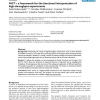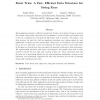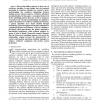692 search results - page 75 / 139 » Hierarchical exploration of large multivariate data sets |
BMCBI
2005
13 years 8 months ago
2005
Background: Interpreting the results of high-throughput experiments, such as those obtained from DNA-microarrays, is an often time-consuming task due to the high number of data-po...
IJCNN
2006
IEEE
14 years 2 months ago
2006
IEEE
— Over time, neural networks have proven to be extremely powerful tools for data exploration with the capability to discover previously unknown dependencies and relationships in ...
GECCO
2007
Springer
14 years 2 months ago
2007
Springer
The main motivation for using a multi–objective evolutionary algorithm for finding biclusters in gene expression data is motivated by the fact that when looking for biclusters ...
TOIS
2002
13 years 8 months ago
2002
Many applications depend on efficient management of large sets of distinct strings in memory. For example, during index construction for text databases a record is held for each d...
DMIN
2006
13 years 10 months ago
2006
Discovering hidden patterns in large sets of workforce schedules to gain insight into the potential knowledge in workforce schedules are crucial to better understanding the workfor...



